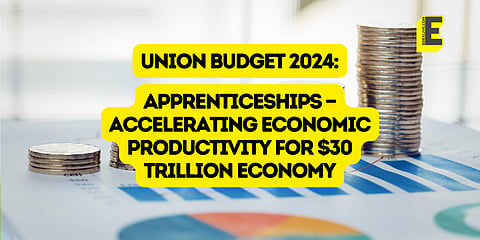

The financial year 2023 witnessed some remarkable achievements in the Indian apprenticeship ecosystem. The number of apprentices almost touched 7 lakh which doubled in the last two years; the successful implementation of Direct Benefit Transfer (DBT) under National Apprenticeship Promotion Scheme (NAPS); and earlier in the year, in an article published in Further Education, United Kingdom (FE, UK), the Indian apprenticeship system was highly praised as one of the best globally, touted better than the ones in UK and the US.
The adoption of apprenticeships could be linked to the changing dynamics of the labour market where skills are gaining preference over qualification, talent is becoming dearer and economic productivity is the priority. Industry players can address talent shortages, option talent costs and improve workforce productivity. Some of the recent trends witnessed in apprenticeships are:
1. Industry-academia collaboration for the execution of degree apprenticeship, under the New Education Policy (NEP) 2020, which has industry micro-credentials and employers can tap talent at the grassroots level.
2. Driving gender diversity for more women participation in the labour force through apprenticeship route workforce.
3. Build future skills (green and sustainable technologies, AI and so on) by leveraging on-the-job training.
4. Increased involvement of a third-party agent (TPA) in supporting the industry in scaling apprenticeship engagement (65% of the apprentices today are handled by TPAs)
Over the last 63 years ever since ACT was written, India has come a long way in scaling the apprenticeship ecosystem, however, apprentices account for just 0.1% participation in the Indian labour market against a developed economy which has a 3-4% participation rate.
There are just 40,000 employers against 1,70,000 registered employers on the apprenticeship portal, and against 63 million enterprises in India that engage with 7 lakh apprentices, that accounts for 17.5 apprentices per employer; although SMEs have always voiced their intent to engage with apprentices their contribution is abysmal, but actively engage skill development informally.
The potential that the country holds is about 20 million apprentices (3% of the Indian workforce); however, there are regulatory, systemic and behavioural interventions are required to scale the apprenticeship ecosystem. In the last two years, the finance minister in her budget speech has referred to amending the apprentice ACT and covering 4.7 million apprentices/ trainees under the Skill India mission to be covered under Direct Beneficiary Transfer (DBT) for NAPS in three years’ time frame. To achieve these goals, here are a few interventions required.
1. Scale degree apprenticeships under New Education Policy, this would require an academia-industry partnership and entail a tripartite contract between, the student apprentice, employer and academic body to facilitate the execution of apprenticeship embedded degree programme.
As UGC guidelines and Apprenticeship ACT are being adhered to execute degree apprenticeship, and three bi-lateral agreements have to be in place (academic body-industry partner, student apprentice-industry, student apprentice-academic body), the process restricts scalability. Introducing, academia as a third party in the Apprentices ACT for degree apprenticeship can simplify the process. Degree Apprenticeships are the innovation in the talent supply chain that perfectly blends education with skills, enhances youth employability, makes financially viable through industry active involvement (stipend and sponsorship), makes apprenticeships aspirational (quality apprenticeships for vertical mobility of apprentices) and can scale Gross Enrolment Ratio (GER).
2. Develop an apprenticeship credit framework that can integrate with the formal education system. Credits are to be allocated for on-the-job and theoretical training under apprenticeships. The credits are to be recognised by the education system.
3. Simplification of our apprenticeship system that’s highly fragmented, regulated and under-utilised due to complexities. The bifurcation of execution of the ACT under two Ministries MSDE and MoE, the role of NSDC Vs BOAT, and schemes NATS Vs NAPS continue to confuse the industry that wants to get started with apprenticeships. A simplified, unified and integrated infrastructure can build a foundation for scale.
4. Empower and enhance the role of TPA which already accounts for 65% of apprenticeship execution for adoption of apprenticeships by SMEs. Group Training Organisations in Australia, which are like TPA, handle SMEs by outsourcing apprentices to them. TPA can be the principal employer that can collaborate with SMEs and let out apprentices for on-the-job training. This could formalise apprenticeships and skill development that is currently so unorganised and informal in the sector.
5. Incentives TPA for mobilising and handling apprentices to motivate and recognise their efforts under Skill India initiatives. Special incentives for mobilising and enrolling women apprentices and candidates from underprivileged sections.
6. Apprenticeships channelise the youth towards formal employment. Revise NAPS criteria Current NAPS is more input-driven, but it should also drive outcome which is formal employment. Employers should be incentivised for a number of apprentices absorbed into employment by them. This can have a direct impact on formal employment.
7. Production Linked Incentive scheme to be linked with Skill India mission. The recent geopolitical and economic reorder has made India a favourable position in the global supply chain. A scheme like PLI opens up employment opportunities and also requires skilled workforce. Incentives under PLI should also be linked to the industry’s active participation in skill development through apprenticeships and other schemes like Pradhan Mantri Kaushal Vikas Yojana (PMKVY) and so on. This can boost the formalisation of skill development in the country.
The desired GDP growth of 7+% and prepare India for a $30 trillion economy by 2047, skilled workforce will play a key role. As much the emphasis has to be on reskilling and upskilling the existing workforce; and recognising their prior experience (RPL) for formalisation of skilled workforce, for sustainable development, we need a simplified and enabling learning/ education system to leverage the demographic dividend for economic productivity. Being the country with the youngest population can only be beneficial if we can convert it into human capital.
(Sumit Kumar is the Chief Strategy Officer, Teamlease Degree Apprenticeship. Views expressed are his own)
